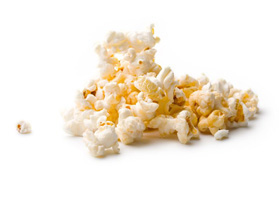Sahara: Funeral Rice
Year Released: 2005
Directed by: Breck Eisner
Starring: Matthew McConaughey, Steve Zahn, Penelope Cruz
(PG-13, 127 min.)

"When elephants fight it is the grass that suffers." African Proverb
Rent Sahara for a lighter take on saving the world. Certainly enjoy this taste of summer sunshine if you missed it in 2005, but beware! Too much sunshine makes a desert.
While many critics are sniggering over the far-fetched aspects of the plot, I think it is the way Sahara presents itself that takes credibility from the movie. Okay, what are the chances of a confederate Ironclad ship from the Civil War resurfacing in the sands of Africa? But Indiana Jones and James Bond have carried off equally far-fetched scenarios. They give you a little wink -- Indiana’s facial expression when he whips out a gun to finish off a sword-wielding assassin, the tilt of Roger Moore’s eyebrow, or even the verging-on-pornographic names of the Bond femme fatales. For the most part, however, they play it relatively straight, and we go along for the ride.
I think it’s rather dandy that at least two of Sahara’s three interweaving plots are credible. Let’s take a closer look and see what you think.
Dirk Pitt (McConaughey) is the Clive Cussler hero who recovers deep-sea artifacts. He has just made his boss, Admiral Sandecker (William H. Macy) proud, by resurrecting a huge gold behemoth, but he checks out of the festivities when he gets wind of the latest clues about his true passion, the ironclad. He and his wisecracking sidekick Al Giordino (Steve Zahn) head off to Africa where a coin from the ship has surfaced.
There they cross paths with Dr. Eva Rojas (Penelope Cruz), who is also on the track of something hot, as well as being of that variety herself, in spite of the drab garbs the World Health Organization has her wear. She is tracing the outbreak of a plague. The only problem is that the source area is in the middle of a civil war and the intrepid U.N. doesn’t want to interfere or get its hands dirty. See what I meant when I said the plot was more credible than you thought. Dr. Rojas, who seems to carry designer gowns in her U.N. duffle bag, shows up at the same gala Dirk is ditching and works her charm on a influential French industrialist with connections to the “he put the war back in warlord” General Kazim. (More credibility points here.)
Along the way they morph into a McGiver episode where the contents of a rusty toolbox convert a wrecked plane into a “totally awesome, Dude” wind surfing machine, desert rather than water variety.
Somehow it all comes down to the old hidden industrial complex in the middle of nowhere theme, with our three adventurers winging their way into its bowels where they find themselves and the whole world in deep---well what do you usually find in bowels, anyway?
Not so bad, eh? But music, casting, and the screenplay take the wind out of those desert sails. Here is where rumors of Cussler suing Paramount do seem reasonable.
Usually, I’m not one to gush over movie scores or even find them particularly relevant, but here it blares out at you. A kind of heavy metal rock makes you feel you are in the video game parlor, not a movie theater. Remember when the chase scene in a Bond movie begins: the rocket launcher switch is tripped in the silver beamer or the gondola suddenly has a turbo jet? We always know it’s coming because of the music, that unmistakable bass line that tells us to buckle up and start pumping the adrenaline. Forget that suspense in Sahara, where we feel more like we’re at a Grateful Dead concert and it is time to PARTY.
“A Yankified James Bond Lite” is what critic Marc Savlov calls Cussler’s vision of Dirk Pitt. In the film it comes out more like James Bond on a bong. And it’s not just McConaughey’s fault. The script doesn’t give him much to establish any seriousness. All we get is a collage of newspaper clippings in the galley of the boat, and even these are interspersed with boyhood photos oh him and kindergarten buddy Al (Zahn). Bond worked alone, when he was in the vertical position, at least, and Indiana had only his hat and the bullwhip as partners. Sure Holmes had Watson, who was made into a bit of a buffoon by Hollywood with Nigel Bruce’s amiable dunce routine, but even in that Hollywood transgression, there is none of the stupid banter and adolescent goofiness that permeates Dirk and Al’s exchanges.
Some have speculated that the well publicized off screen romance between Cruz and McConaughey is actually to compensate for their lack of “reel” chemistry. I again fault the script, which spent all its times on thrills and narrow escapes and devoted very little to character and sexual tension. Dr. Rojas falls in with if not for Pitt immediately. He playfully suggests visiting a workaholic doctor at her seaside retreat in Monterey, and she smiles coquettishly. Maureen O’Hara would never have given Duke such easy entry, and his face would soon be smarting from the red imprint of her delicate Irish hand.
Those criticisms aside, Sahara is still a good ride on a variety of vehicles – boats as well as “planes, trains, automobiles, helicopters, dune buggies, wind-propelled airplane carcasses, and camels,” as Roger Ebert lists them. There’s the super smart heroine hiding her beauty behind earnest looks and glasses -- I think it used to be the other way around -- and the dashing hero who only reluctantly gets sucked into saving the world. Not to mention the harsh beauty of the desert, the cerulean blue of the ocean, the vibrant patchwork squalor of the marketplace, the glory of desert steeds drinking the wind, and a series of villains with particularly bad skin.
—Kathy Borich
Film-Loving Foodie
The rebel tribe that takes Dirk and company in live in sandstone colored compound perched on the hillside. They are skilled horseman, courageous warriors, and generous hosts, who keep scholarly documents recording their history. We must assume that their meals would reflect their simple nobility.
The rice dish I have chosen has three different names. The last one is sadly appropriate for several of the Africans in Sahara.
Funeral Rice
South Africa's oldest rice dish is vendusierys (auction rice) which was later known as huweliksrys (wedding rice) or begrafnisrys (funeral rice). It is simply yellow rice with raisins.
8 servings. 50 minutes 10 mins prep
Ingredients
- 6 1/3 cups water
- 14 1/8 ounces rice
- 2 1/16 teaspoons salt
- 3/4 ounce yellow sugar
- 5/8 teaspoon saffron or 2 1/16 teaspoons turmeric
- 3 cinnamon sticks or 3 pieces cassia
- 8 cardamom seeds
- 1 1/16 tablespoons naartjie peel, cut into strips (optional)
- 1 7/8ounces butter
- 2 2/3 ounces sultanas, mixed with raisins
- 2 2/3 ounces raisins or 5 1/3 ounces seedless raisins
Directions
- Heat the water to boiling point in a large saucepan.
- Meanwhile, rinse the rice, and place it in the boiling water.
- Stir in the salt, sugar and saffron, and add the sticks of cinnamon, cardamom seeds and naartjie peel.
- Cover, reduce the heat and then simmer for 20-30 minutes.
- Remove the saucepan from the heat and pour off the water.
- Add the butter, sultanas and raisins and stir to blend.
- Spoon into a colander.
- Meanwhile, boil a kettleful of water and pour it into the saucepan in which the rice was cooked.
- Heat to boiling point.
- Place the colander of rice on top, cover and steam until the rice has swollen and the raisins are soft and plump.
Recipe Source: food.com



 Rainy Day Rentals
Rainy Day Rentals